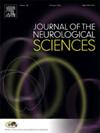Frequency of subclavian steal syndrome in a sample of non-Western population
IF 3.6
3区 医学
Q1 CLINICAL NEUROLOGY
引用次数: 0
Abstract
Background
Subclavian steal syndrome (SSS) is not rarely found during ultrasound examinations. Previous reports demonstrated a relation between ethnic factors and SSS. Data regarding SSS in non-Western population are still lacking. We aimed to investigate the frequency of SSS in a sample of Egyptian population.
Methods
In a single-center observational study, we conducted a retrospective analysis of successive patients with competent ultrasound examinations of the brain supplying vessels. The patients presented to our neurovascular laboratory in the context of routine clinical practice.
Results
We enrolled 514 patients in our study. SSS was detected in 9 patients (1.8 %) with a median (IQR) age of 58 (56–63) years. One patient with second-degree SSS received a subclavian stent. Among patients with SSS, 4 patients (44.4 %) had carotid atherosclerosis, 4 patients (44.4 %) had ischemic vascular events in the posterior circulation, and two (22.2 %) had hemodynamically significant carotid stenosis ≥50 %. Using a ROC curve, an interarm SBP (systolic blood pressure) difference of ≥10 mmHg had a sensitivity of 77.8 % and specificity of 66 %, whereas a difference of ≥20 mmHg was associated with a sensitivity of 55.6 % and specificity of 92.4 % for SSS (AUC 0.79, 95 % CI 0.6–0.97, p = 0.004).
Conclusions
SSS is not rare among Egyptian population and should be in mind during ultrasound examination, especially for patient with ischemic events in the posterior circulation and those with significant interarm SBP difference.
锁骨下窃血综合征在非西方人群中的发病率。
背景:锁骨下窃血综合征(SSS)在超声检查中并不罕见。以往的报道证实了种族因素与SSS之间的关系。关于非西方人口SSS的数据仍然缺乏。我们的目的是调查SSS在埃及人群样本中的频率。方法:在一项单中心观察性研究中,我们对连续接受脑供血血管超声检查的患者进行了回顾性分析。在常规临床实践的背景下,患者来到我们的神经血管实验室。结果:我们入组了514例患者。9例(1.8%)患者检测到SSS,中位(IQR)年龄为58(56-63)岁。一名二度SSS患者接受了锁骨下支架。SSS患者中,颈动脉粥样硬化4例(44.4%),后循环缺血性血管事件4例(44.4%),颈动脉血流动力学显著狭窄≥50% 2例(22.2%)。ROC曲线显示,收缩压臂间差异≥10 mmHg对SSS的敏感性为77.8%,特异性为66%,而差异≥20 mmHg对SSS的敏感性为55.6%,特异性为92.4% (AUC 0.79, 95% CI 0.6-0.97, p = 0.004)。结论:SSS在埃及人群中并不罕见,超声检查时应注意,特别是后循环缺血事件和臂间收缩压明显差异的患者。
本文章由计算机程序翻译,如有差异,请以英文原文为准。
求助全文
约1分钟内获得全文
求助全文
来源期刊

Journal of the Neurological Sciences
医学-临床神经学
CiteScore
7.60
自引率
2.30%
发文量
313
审稿时长
22 days
期刊介绍:
The Journal of the Neurological Sciences provides a medium for the prompt publication of original articles in neurology and neuroscience from around the world. JNS places special emphasis on articles that: 1) provide guidance to clinicians around the world (Best Practices, Global Neurology); 2) report cutting-edge science related to neurology (Basic and Translational Sciences); 3) educate readers about relevant and practical clinical outcomes in neurology (Outcomes Research); and 4) summarize or editorialize the current state of the literature (Reviews, Commentaries, and Editorials).
JNS accepts most types of manuscripts for consideration including original research papers, short communications, reviews, book reviews, letters to the Editor, opinions and editorials. Topics considered will be from neurology-related fields that are of interest to practicing physicians around the world. Examples include neuromuscular diseases, demyelination, atrophies, dementia, neoplasms, infections, epilepsies, disturbances of consciousness, stroke and cerebral circulation, growth and development, plasticity and intermediary metabolism.
 求助内容:
求助内容: 应助结果提醒方式:
应助结果提醒方式:


